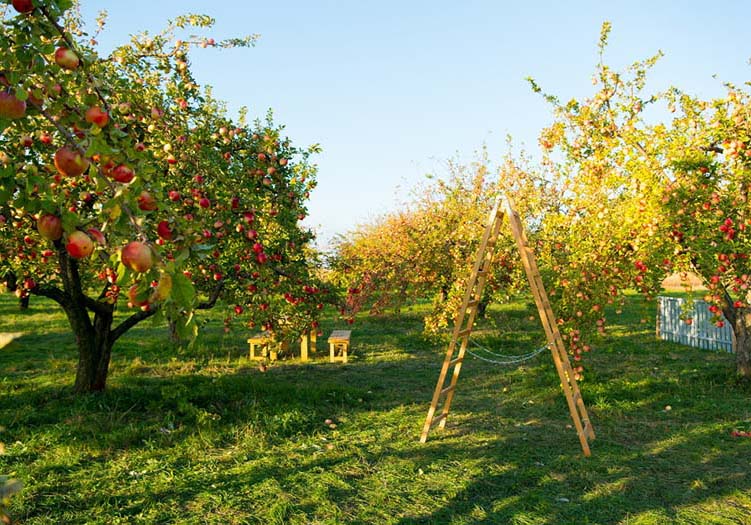Your shopping cart is currently empty.
| Subtotal | €0,00 |
| Shipping Rate | including VAT, excl. Shipping Rate |
| Total | €0,00 |
|---|
02.05.2023
Content:
- apple tree origin
- Apple tree care and location
- pruning apple trees
- Do you have to fertilize apple trees?
- Water the apple tree properly!
apple tree origin
The apple tree is a deciduous deciduous tree. It belongs to the rose family and is a relatively small tree at five to ten meters in height. It forms a densely branched crown.
The wild form of the apple tree has been found in European forests since the Stone Age. But these only carry sour crab apples. Today, most apple varieties come from a sweet variety (malus sieversii) which has been cultivated in the Almaty area of Kazakhstan for over 2000 years.
There are now thousands of different varieties that have also been crossed with wild crab apples – or that have been grafted onto their rootstock.
If you would like to provide yourself with your own fruit, you should plant an apple tree, because no tree here produces larger quantities of fruit.
Apple trees bloom between April and May, depending on where they are located. The flowers are white to pink. They often form new shoots only after the apple blossoms have faded. The leaves of the apple tree are ovate with a serrated edge.
The fruits of most varieties of the apple tree are ripe between September and November. The fruits of the apple tree are usually spherical and have a green, yellow, orange or red color depending on the variety.
Apple tree care and location
The apple tree prefers a sunny location, but it also tolerates shade. Since the open blossoms of most apple varieties are sensitive to cold, it is important to choose a location that is not endangered by late frost.
Apple trees prefer one deep, nutrient-rich soil which is well supplied with humus.
The apple tree is a Shallow roots. Its roots do not reach deep into the ground but are widespread just below the surface. If the roots close to the ground are removed or injured by construction or soil work, it cannot compensate for this with deep-reaching taproots.
pruning apple trees
Most varieties should be pruned regularly to keep the apples from shrinking in size over time and keep the apple tree healthy and vigorous.
Do you have to fertilize apple trees?
Apple trees are among the strong-bearing trees and therefore have a high nutrient requirement. It is therefore advisable to fertilize them regularly. Nitrogen and potassium are particularly important. To fertilize an apple tree in spring, you can add horn splint to the root area or well-rotted compost. It is also a good idea to plant nitrogen-fixing and potassium-enriching plants, such as comfrey, near the apple tree.
Water the apple tree properly!
Due to climate change, our regions are also getting hotter and drier. Many trees suffer from the extreme conditions. Depending on the location and the climate-related situation, more frequent watering than in previous years may be necessary.
When apple trees suffer from a lack of water, you can see it. Due to the dryness, the branches become softer, the wood bends and branches can break off. If an apple tree has been exposed to a lack of water for a long time, this is reflected in the discoloration and drying up of the leaves. At least now it's time to apple tree to water.
Watering apple trees is especially important if you want to have a bounty harvest. If there are already dry phases in the spring or if there has been a dry winter in which the groundwater could not fill up sufficiently and the soil moisture could not regenerate, the apple trees should be watered in the spring. This is especially true for young trees.
During the summer months you should Depending on the location and size, water an apple tree 1-3 times a week with 75 - 200 liters of water.
When watering conventionally with a watering can or garden hose, only a small part of the water poured is absorbed by the soil in the root area of the apple tree. Large amounts of water usually flow away on the surface and evaporate again because the soil often cannot absorb them quickly enough. Or in loose soils, they seep through the root area of the shallow-rooted apple trees and can therefore no longer be absorbed by them.
The tree bath watering bag release the water drop by drop to the tree through two small holes over a period of several hours. This ensures that the soil is evenly moist throughout the root area, which means that the roots can absorb the water well.
Attaching and filling the water bags is easy and uncomplicated. The bag is placed around the tree trunk like a jacket and closed with the zipper. In the next step, fill the watering bag with enough water so that no creases can be seen after further alignment in the lower area and then let it fill up. In the case of apple trees with larger trunk diameters, several bags can also be connected with the zipper.
Once the water has run through, the bag is removed again and can be used for other trees. This saves water, time and money.
Do you want more tree knowledge?
That might interest you
Great idea, easy handling and everything from ordering to delivery.
Michael K.
















